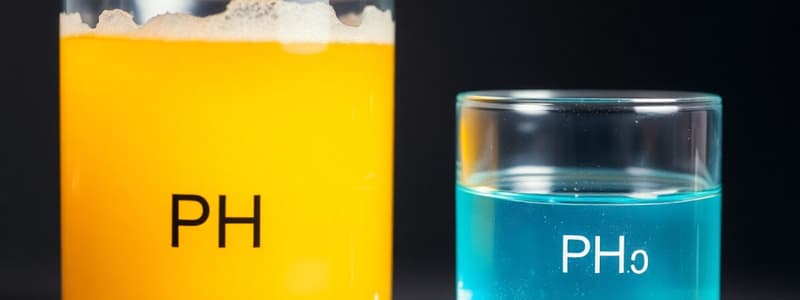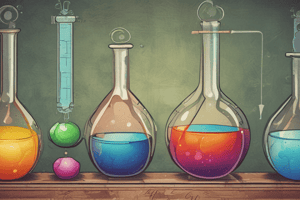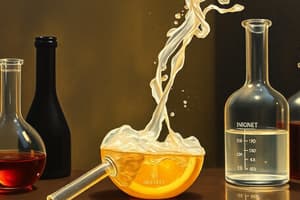Podcast
Questions and Answers
Which statement accurately contrasts Arrhenius and Brønsted-Lowry bases?
Which statement accurately contrasts Arrhenius and Brønsted-Lowry bases?
- Brønsted-Lowry bases produce hydronium ions, while Arrhenius bases accept protons.
- Arrhenius bases are limited to aqueous solutions, while Brønsted-Lowry bases can function in non-aqueous environments. (correct)
- Brønsted-Lowry bases always involve the transfer of electrons, while Arrhenius bases involve the transfer of protons.
- Arrhenius bases donate protons, while Brønsted-Lowry bases produce hydroxide ions in water.
How does the autoionization of water contribute to the understanding of acid-base chemistry?
How does the autoionization of water contribute to the understanding of acid-base chemistry?
- It illustrates water's amphoteric nature and the existence of both hydronium and hydroxide ions in pure water.
- It proves that water is a strong acid and a strong base simultaneously.
- It establishes that the concentration of hydronium ions is always greater than hydroxide ions. (correct)
- It demonstrates that water can only act as an acid in the presence of a strong base.
What is the significance of $K_w$ in acid-base chemistry?
What is the significance of $K_w$ in acid-base chemistry?
- It indicates the strength of a strong acid or a strong base.
- It determines whether a solution is acidic, basic, or neutral, independent of temperature.
- It represents the equilibrium constant for acid-base neutralization reactions. (correct)
- It quantifies the degree of autoionization of water and relates hydronium and hydroxide ion concentrations.
In the context of acid-base chemistry, what is the correct interpretation of the ‘p' function?
In the context of acid-base chemistry, what is the correct interpretation of the ‘p' function?
How does the extent of dissociation differentiate weak acids/bases from strong acids/bases in aqueous solutions?
How does the extent of dissociation differentiate weak acids/bases from strong acids/bases in aqueous solutions?
What is the primary utility of an ICE table in the context of weak acid/base equilibria?
What is the primary utility of an ICE table in the context of weak acid/base equilibria?
How does the strength of an acid or base relate to the strength of its conjugate?
How does the strength of an acid or base relate to the strength of its conjugate?
Which of the following statements correctly describes a polyprotic acid?
Which of the following statements correctly describes a polyprotic acid?
What is the main factor determining whether a salt solution will be acidic, basic, or neutral?
What is the main factor determining whether a salt solution will be acidic, basic, or neutral?
In a solution containing both a strong acid and a weak acid, how is the pH typically determined?
In a solution containing both a strong acid and a weak acid, how is the pH typically determined?
When ammonium chloride ($NH_4Cl$) dissolves in water, what process affects the pH of the solution?
When ammonium chloride ($NH_4Cl$) dissolves in water, what process affects the pH of the solution?
Which of the following is the broadest definition of an acid?
Which of the following is the broadest definition of an acid?
What is the correct conjugate acid for $NH_3$?
What is the correct conjugate acid for $NH_3$?
In a titration, a solution has a pH of 3. What is the concentration of $H^+$?
In a titration, a solution has a pH of 3. What is the concentration of $H^+$?
Which of the following is a strong acid?
Which of the following is a strong acid?
Which of the following is a diprotic acid?
Which of the following is a diprotic acid?
What is the product of the concentrations of hydronium ($H_3O^+$) and hydroxide ($OH^−$) ions in water at 25°C?
What is the product of the concentrations of hydronium ($H_3O^+$) and hydroxide ($OH^−$) ions in water at 25°C?
What is true about strong acids and bases?
What is true about strong acids and bases?
If you have the $K_a$ of a weak acid, how can you determine the $K_b$ of its conjugate base?
If you have the $K_a$ of a weak acid, how can you determine the $K_b$ of its conjugate base?
If $pOH = 5$, what is the $pH$?
If $pOH = 5$, what is the $pH$?
Which of the following salts would produce a basic solution when dissolved in water?
Which of the following salts would produce a basic solution when dissolved in water?
What is true about Amphoteric substances?
What is true about Amphoteric substances?
What happens when strong acids/bases are added to water?
What happens when strong acids/bases are added to water?
What does 'acid' actually mean in acid-base chemistry?
What does 'acid' actually mean in acid-base chemistry?
According to the information provided, if pH increases, what happens to the concentration of hydronium ions?
According to the information provided, if pH increases, what happens to the concentration of hydronium ions?
Why isn't $H^+$ found alone in water?
Why isn't $H^+$ found alone in water?
What is true about Lewis acids and bases?
What is true about Lewis acids and bases?
What is true about the conjugates of strong acids and bases?
What is true about the conjugates of strong acids and bases?
If $K_a = 1 * 10^{-5}$, will the conjugate base have a low or high $K_b$?
If $K_a = 1 * 10^{-5}$, will the conjugate base have a low or high $K_b$?
Common strong bases include:
Common strong bases include:
If you have the following reaction: $HA + H_2O = H_3O^+ + A^-$. Which of the following is the Kₐ equation?
If you have the following reaction: $HA + H_2O = H_3O^+ + A^-$. Which of the following is the Kₐ equation?
Flashcards
Define Arrhenius acids and bases
Define Arrhenius acids and bases
Arrhenius acids produce H+ ions in water, and Arrhenius bases produce OH- ions in water.
Define Brønsted-Lowry acids and bases
Define Brønsted-Lowry acids and bases
Acids are proton donors and bases are proton acceptors.
Conjugate acid-base pair
Conjugate acid-base pair
Two substances differing by one proton (H+). Example: HF and F-.
Conjugate base/acid of NH3
Conjugate base/acid of NH3
Signup and view all the flashcards
Autoionization of water
Autoionization of water
Signup and view all the flashcards
Define Amphoteric
Define Amphoteric
Signup and view all the flashcards
H⁺, hydronium ion, and a proton
H⁺, hydronium ion, and a proton
Signup and view all the flashcards
Kw and pH scale
Kw and pH scale
Signup and view all the flashcards
pH of strong acid/base
pH of strong acid/base
Signup and view all the flashcards
7 strong acids
7 strong acids
Signup and view all the flashcards
Identify strong base
Identify strong base
Signup and view all the flashcards
pH and pOH related
pH and pOH related
Signup and view all the flashcards
Meaning of 'weak' acid/base
Meaning of 'weak' acid/base
Signup and view all the flashcards
ICE charts for weak acids and bases
ICE charts for weak acids and bases
Signup and view all the flashcards
Strength of acids/bases and conjugates
Strength of acids/bases and conjugates
Signup and view all the flashcards
Diprotic acid
Diprotic acid
Signup and view all the flashcards
Polyprotic
Polyprotic
Signup and view all the flashcards
Salt solution pH factors
Salt solution pH factors
Signup and view all the flashcards
Lewis acids and bases
Lewis acids and bases
Signup and view all the flashcards
Study Notes
Introduction to Acids, Bases, and pH
- Arrhenius acids yield H⁺ ions in water; Arrhenius bases yield OH⁻ ions in water
- Brønsted-Lowry acids are proton donors; Brønsted-Lowry bases are proton acceptors
- A conjugate acid-base pair includes two substances differing by one proton (H⁺)
- HF and F⁻ are a conjugate acid-base pair because HF donates a proton to become F⁻ and F⁻ accepts a proton to become HF
Conjugate Acids and Bases
- The conjugate base for NH₃ (ammonia) is NH₂⁻
- The conjugate acid for NH₃ is NH₄⁺ (ammonium ion)
- When writing the conjugate base, the initial species acts like an acid by donating a proton
- To write the conjugate acid, the starting species acts like a base that accepts a proton
Autoionization of Water
- The autoionization of water is represented by: H₂O(l) + H₂O(l) ⇌ H₃O⁺(aq) + OH⁻(aq)
- The expression for Kw is: Kw = [H₃O⁺][OH⁻] = 1.0 × 10⁻¹⁴ at 25°C
- Kw is derived from the equilibrium constant expression (products over reactants) for water's autoionization
Amphoteric Substances
- An amphoteric substance acts as both an acid and a base
- Water (H₂O) is a good example, as it can donate (acting as an acid) or accept a proton (acting as a base)
Relationship Between H+, Hydronium Ion, and a Proton
- H⁺ is simply a proton, a hydrogen atom lacking its electron
- H⁺ doesn't exist alone in water, it combines with a water molecule to form H₃O⁺ (hydronium ion)
- H⁺ and H₃O⁺ are often used interchangeably to denote hydrogen ions in solution, especially in pH calculations
- Although technically more correct, some general chemistry resources still use H⁺
Kw and the pH Scale
- Kw is the product of H₃O⁺ (hydronium) and OH⁻ (hydroxide) concentrations in water
- The pH scale relies on the concentration of H₃O⁺ in a solution
- When [H₃O⁺] increases, pH drops; when [H₃O⁺] decreases, pH rises
- A neutral solution has a pH of 7, where [H₃O⁺] = [OH⁻]
- The pH scale is most accurate at 25°C
- An acidic solution has a pH under 7, and a basic solution has a pH above 7
pH Calculation for Strong Acids and Bases
- Strong acids fully dissociate, all strong acid produces H⁺ ions (HCl → H⁺ + Cl⁻)
- You can determine the pH of a strong acid via the negative logarithm of the strong acid's concentration: [HCl] = [H⁺] = [H₃O⁺]
- For strong bases, [NaOH] = [OH⁻] but for Ba(OH)₂, the [OH⁻] is twice the [Ba(OH)₂]: Ba(OH)₂ → Ba²⁺ + 2OH⁻
- Can use the pH equations, or pOH = log[OH⁻], then, pH = 14 – pOH
Strong Acids and Bases
- The 7 strong acids include: HCl (hydrochloric), HBr (hydrobromic), HI (hydroiodic), HNO₃ (nitric), HClO₄ (perchloric), H₂SO₄ (sulfuric), and HClO₃ (chloric)
- Strong bases completely dissociate in water to produce OH⁻ ions
- Common examples include Group 1 metal hydroxides like NaOH (sodium hydroxide) and KOH (potassium hydroxide), and Group 2 metal hydroxides like Ba(OH)₂ (barium hydroxide)
pH, pOH, and the 'p' Function
- The 'p' function in chemistry signifies "the negative logarithm of"
- pH = -log[H⁺]
- pOH = log[OH-]
Weak Acids and Bases
- Weak acids/bases only partially dissociate in water; not all molecules break apart into ions
- This makes them less effective at donating/accepting protons compared to strong acids/bases
Equilibrium Expressions
- For a weak acid: HA + H₂O ⇌ H₃O⁺ + A⁻, equilibrium expression: Ka = [H₃O⁺][A⁻] / [HA]
- For a weak base: B + H₂O ⇌ BH⁺ + OH⁻, the equilibrium expression: Kb = [BH⁺][OH⁻] / [B]
Calculating pH for Weak Acids or Bases
- Calculated using the equilibrium expression (Ka or Kb) and an ICE table
- Is different than strong acids/bases because they fully dissociate, making it easier to calculate pH directly from their initial concentrations—no ICE table needed for strong species.
- Requires finding the equilibrium concentrations of hydronium or hydroxide ions, depending on the acid or base
ICE Charts
- In ICE charts for weak acids/bases, the chemical equation at the top is:
- acid + water ⇌ hydronium ion + conjugate base, or
- base + water ⇌ hydroxide ion + conjugate acid
ICE Chart Problems
- In ICE chart problems, use the equilibrium constant to find missing info or use the pH and concentration to completely fill out the ICE table to calculate the equilibrium constant
- Similar flavors to problems in chapter 15, but need the additional step of using pH equations to go between concentrations and pH/pOH
- Can almost always use approximation in chapter 16
Acid and Base Strength
- The stronger acid will have a weaker conjugate base, and the stronger base will have a weaker conjugate acid.
- Conjugates of strong acids and bases are considered so weak that they don’t have any acid/base properties
- The relationship Ka × Kb = Kw, where if an acid has a high Ka, its conjugate base will have a low Kb, and vice versa.
Polyprotic Acids
- Diprotic acids like H₂SO₄ donate two protons (H⁺)
- Polyprotic acids like H₃PO₄ can donate more than one proton
- HF is monoprotic and only donates 1 proton
Salt Solutions
- The pH of a salt solution depends on the strength of the acid and base from which the salt is made
- A salt from a strong acid and weak base will form an acidic solution
- A salt from a weak acid and strong base will form a basic solution
- A salt from a strong acid and base will make a neutral solution
pH Calculation
- Requires calculating by breaking the salt into component ions and determining whether each ion is a strong/weak acid/base
- Conjugates of strong acids/bases are considered so weak they are neutral
Mixed Acid/Base Solutions
- To find the pH of a solution with a strong and weak acid, you need the concentration of hydronium ions
- Determine the pH by ignoring the hydronium ions the weak acid/base produces because they are so small compared to the amount produced by the strong acid that it can be ignored
Salt Hydrolysis
- When ammonium chloride (NH₄Cl) dissolves in water, it hydrolyzes: NH₄Cl (s) → NH₄⁺ (aq) + Cl⁻ (aq)
- NH₄⁺ acts as a weak acid, donating a proton to water: NH₄⁺ (aq) + H₂O (l) ⇌ NH₃ (aq) + H₃O⁺ (aq), making the solution acidic
- Cl⁻ ions does not affect pH
Lewis Acids and Bases
- Lewis acids accept a pair of electrons; Lewis bases donate a pair of electrons
- Arrhenius is the most specific definition of acids and bases
- Lewis is the broadest
- All Arrhenius acids are Lewis acids
- Not all Lewis acids are Arrhenius acids
Studying That Suits You
Use AI to generate personalized quizzes and flashcards to suit your learning preferences.
Related Documents
Description
Learn about acids, bases, and pH, including Arrhenius and Brønsted-Lowry definitions. Understand conjugate acid-base pairs and the autoionization of water. Explore calculating Kw and its significance.



